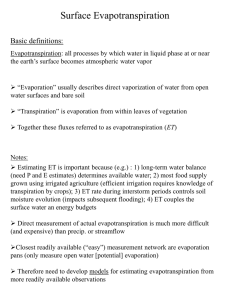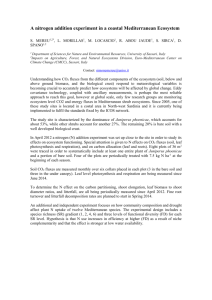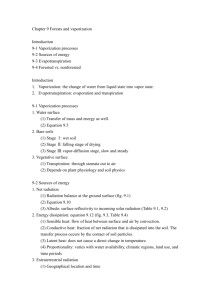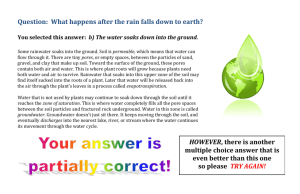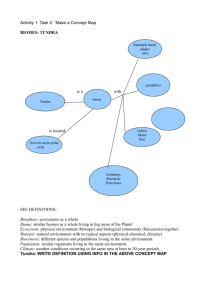fec12127-sup-0003-AppendixS2
advertisement
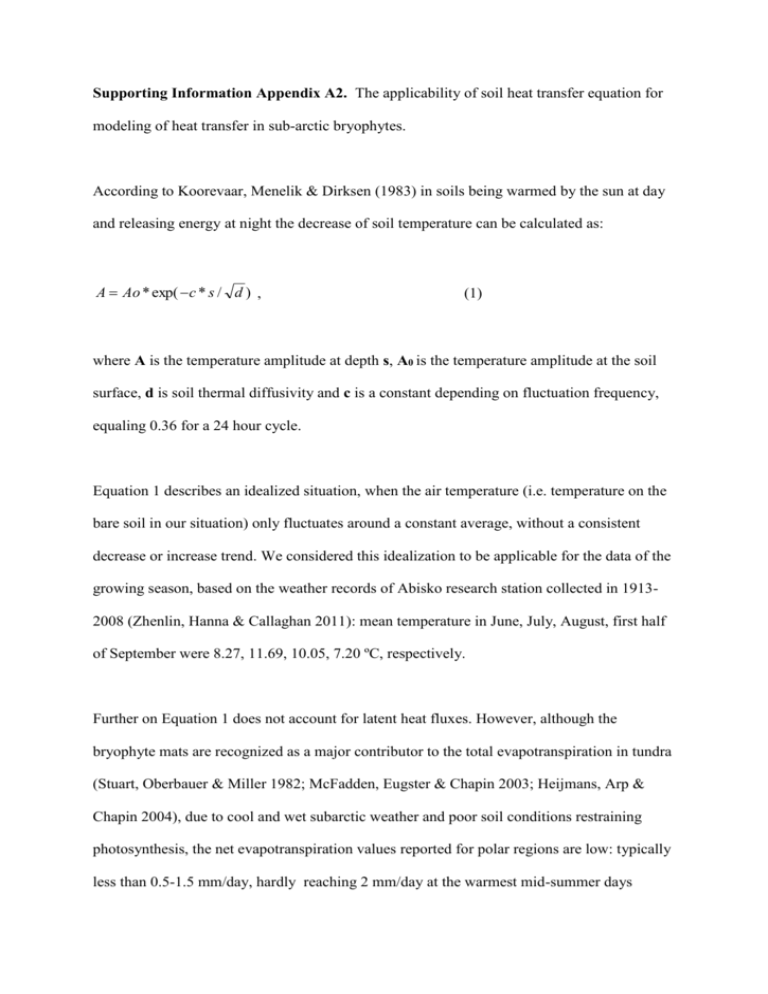
Supporting Information Appendix A2. The applicability of soil heat transfer equation for modeling of heat transfer in sub-arctic bryophytes. According to Koorevaar, Menelik & Dirksen (1983) in soils being warmed by the sun at day and releasing energy at night the decrease of soil temperature can be calculated as: A Ao * exp( c * s / d ) , (1) where A is the temperature amplitude at depth s, A0 is the temperature amplitude at the soil surface, d is soil thermal diffusivity and c is a constant depending on fluctuation frequency, equaling 0.36 for a 24 hour cycle. Equation 1 describes an idealized situation, when the air temperature (i.e. temperature on the bare soil in our situation) only fluctuates around a constant average, without a consistent decrease or increase trend. We considered this idealization to be applicable for the data of the growing season, based on the weather records of Abisko research station collected in 19132008 (Zhenlin, Hanna & Callaghan 2011): mean temperature in June, July, August, first half of September were 8.27, 11.69, 10.05, 7.20 ºC, respectively. Further on Equation 1 does not account for latent heat fluxes. However, although the bryophyte mats are recognized as a major contributor to the total evapotranspiration in tundra (Stuart, Oberbauer & Miller 1982; McFadden, Eugster & Chapin 2003; Heijmans, Arp & Chapin 2004), due to cool and wet subarctic weather and poor soil conditions restraining photosynthesis, the net evapotranspiration values reported for polar regions are low: typically less than 0.5-1.5 mm/day, hardly reaching 2 mm/day at the warmest mid-summer days (McFadden, Eugster & Chapin 2003; Heijmans, Arp & Chapin 2004; Fitzjarrald & Moore 1992; Harding & Lloyd 1998; Soegaard et al. 2001). Indeed, numerous studies (cf. reviews Sellers et al. 1997; Wang & Dickinson 2012) point out that heat fluxes in tundra and boreal areas are dominated by sensible heat with latent heat constituting a small fraction of the total heat flux. Blok et al. (2011) directly showed in similar climatic conditions that the temperature under the surface of bryophyte mats and bare soil was not noticeably reduced by evapotranspiration. Moreover, in our own field experiment we also detected absence of soil temperature reduction effect of bryophytes observed over the whole vegetation season (see the Results for details), which as well suggests that latent heat fluxes in bryophyte mats are very small. Therefore, we considered ignorance of these fluxes in bryophyte mats to be an acceptable assumption in our model. References Blok , D., Heijmans, M.M.P.D., Schaepman-Strub, G., van Ruijven, J., Parmentier, F.J.W., Maximov, T.C. & Berendse, F. (2011) The cooling capacity of mosses: controls on water and energy fluxes in a siberian tundra site. Ecosystems, 14, 1055–1065. Fitzjarrald, D.R. & Moore, K.E. (1992) Turbulent transports over tundra. Journal of Geophysical Research-Atmospheres, 97, 16717-16729. Harding, R.J. & Lloyd, C.R. (1998) Fluxes of water and energy from three high latitude tundra sites in Svalbard. Nordic Hydrology, 29, 267-284. Heijmans, M., Arp, W.J. & Chapin, F.S. (2004) Controls on moss evaporation in a boreal black spruce forest. Global Biogeochemical Cycles, 18. Koorevaar, P., Menelik, G. & Dirksen, C. (1983) Elements of soil physics. Elsvier, Amsterdam. McFadden, J.P., Eugster, W. & Chapin, F.S. (2003) A regional study of the controls on water vapor and CO2 exchange in arctic tundra. Ecology, 84, 2762-2776. Sellers, P.J., Hall, F.G., Kelly, R.D., Black, A., Baldocchi, D., Berry, J., Ryan, M., Ranson, K.J., Crill, P.M., Lettenmaier, D.P., Margolis, H., Cihlar, J., Newcomer, J., Fitzjarrald, D., Jarvis, P.G., Gower, S.T., Halliwell, D., Williams, D., Goodison, B., Wickland, D.E. & Guertin, F.E. (1997) BOREAS in 1997: Experiment overview, scientific results, and future directions. Journal of Geophysical ResearchAtmospheres, 102, 28731-28769. Soegaard, H., Hasholt, B., Friborg, T. & Nordstroem, C. (2001) Surface energy- and water balance in a high-arctic environment in NE Greenland. Theoretical and Applied Climatology, 70, 35-51. Stuart, L., Oberbauer, S. & Miller, P.C. (1982) Evapotranspiration measurements in eriophorum-vaginatum tussok tundra in Alaska. Holarctic Ecology, 5, 145-149. Wang, K.C. & Dickinson, R.E. (2012) A review of global terrestrial evapotranspiration: observation, modeling, climatology, and climatic variability. Reviews of Geophysics, 50. Zhenlin, Y., Hanna, E. & Callaghan, T.V. (2011) Modelling surface-air-temperature variation over complex terrain around Abisko, Swedish Lapland: uncertainties of measurements and models at different scales. Geografiska Annaler Series a-Physical Geography, 93A, 89-112.

